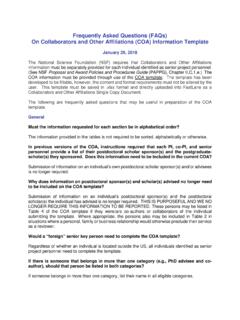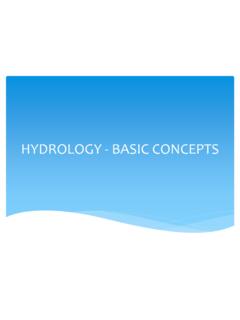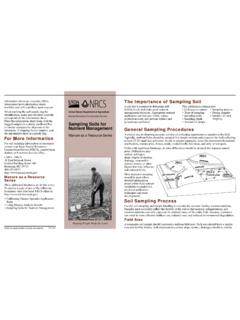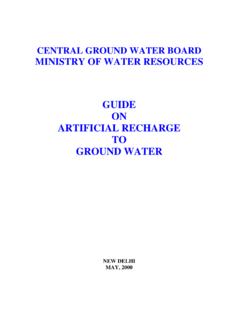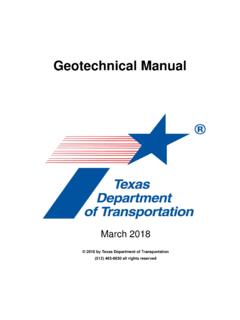Transcription of SUSTAINABLE URBAN SYSTEMS: ARTICULATING A LONG …
1 SUSTAINABLE URBAN SYSTEMS: ARTICULATING A LONG-TERM CONVERGENCE RESEARCH AGENDAJANUARY 2018A REPORT BY THE ADVISORY COMMITTEE FOR ENVIRONMENTAL RESEARCH & EDUCATIONPREPARED BY THE SUSTAINABLE URBAN SYSTEMS SUBCOMMITTEESPONSORED BY THE NATIONAL SCIENCE FOUNDATION SUSTAINABLE URBANSYSTEMS SUBCOMMITTEEAnu Ramaswami (Chair)Humphrey School of Public AffairsUniversity of MinnesotaLuis BettencourtMansueto Institute for URBAN InnovationUniversity of ChicagoAndres ClarensDepartment of Civil and Environmental EngineeringUniversity of VirginiaSajal DasDepartment of Computer ScienceMissouri University of Science and TechnologyGarrett FitzgeraldUrban Sustainability Directors Network USAE lena IrwinDepartment of Agriculture, Environmental, and Developmental EconomicsThe Ohio State UniversityDiane PatakiDepartment of BiologyUniversity of UtahStephanie PincetlInstitute of the Environment and SustainabilityUniversity of California.
2 Los AngelesKaren SetoYale School of Forestry and Environmental StudiesYale UniversityPaul WaddellDepartment of City and Regional PlanningUniversity of California, BerkeleySTAFFLeah G. NicholsAC ERE Executive SecretaryOffice of Integrative ActivitiesNational Science FoundationSamuel TaboryResearch AssociateHumphrey School of Public AffairsUniversity of MinnesotaSUSTAINABLE URBAN SYSTEMS | Report 20182 CONTENTSS ustainable URBAN Systems Subcommittee 0204 Executive Summary 08I. Rationale 12II. SUSTAINABLE URBAN Systems 13 III. The Current Landscape 16IV. Key Features of Next-Generation SUSTAINABLE URBAN Systems Science18V. Illustrative Examples 22VI. Recommendations for Developing a SUSTAINABLE URBAN Systems Research Agenda References 26 CREDIT > SEAN PAVONEEXECUTIVE SUMMARYThis report articulates a vision and a compelling research agenda for developing the next generation of SUSTAINABLE URBAN systems science.
3 It identifies fundamental research questions that need to be answered so that the transformative social and technological changes forecasted in URBAN areas may be harnessed to benefit society at all scales-local, national, and importance OF URBAN AREAS URBAN areas are centers of innovation that generate more than 80% of the global Gross Domestic Product (GDP), and will house nearly 66% of the world s population by the year 2050, almost doubling our current URBAN population in a very short time. This scale and pace of urbanization has never before been seen in human history. Several recent high-level reports have identified that we now live on an URBAN planet where URBAN areas, although occupying only 3% to 4% of the land surface, are impacting human and environmental well-being from local to global scales at unprecedented levels in complex ways that are poorly understood.
4 In the United States (US), URBAN areas are home to approximately 80% of the population and generate 85% of the national GDP, making these locales critical for local and national prosperity, security, and complex transboundary interactions and teleconnections yield a new conceptualization of URBAN systems as multiscale, interdependent social, natural and engineered systems that impact human and planetary well-being across spatial (local to global) and temporal NEW CONCEPTUALIZATION OF TRANSBOUNDARY URBAN SYSTEMS While engines of innovation, URBAN areas face challenges of: aging/inadequate infrastructure; health risks from pollution, poor diets, and sedentary lifestyles; vulnerability to disasters and extreme events; and inequities in economic opportunity, risk-exposure, and human well-being.
5 Furthermore, the high concentration of human activities in URBAN areas creates large transboundary flows of people, natural resources, goods and services (including multiple essential infrastructures and food supply), information, innovation, waste, and pollution through networks of trade, migration, infrastructure, and information the impacts of which extend well beyond URBAN administrative boundaries. For example: energy use in URBAN areas CREDIT > KEVIN P. SIUSUSTAINABLE URBAN SYSTEMS | Report 20184contributes to more than 70% of global greenhouse gas emissions; water supply to just 50 of the world s largest cities draws upon watersheds covering 41% of the world s land surface; social and technological innovations in cities have reverberating impacts on surrounding rural areas, as well as across networks of cities connected via trade, nationally and internationally.
6 URBAN areas, in turn, are impacted by regional and global processes, with social, economic, environmental, and health consequences. These complex interactions and teleconnections yield a new conceptualization of URBAN systems as transboundary, multiscale, interdependent social, natural and engineered systems that impact human and planetary well-being across spatial (local-to-global) and temporal FOR MULTIPLE CONVERGENT URBAN TRANSITIONS Multiple transitions are converging in URBAN areas over the next decade that present a historic opportunity to improve human and environmental well-being, locally and globally, thereby advancing sustainability. Examples include: demographic transitions ( , aging populations in US cities versus exploding urbanization and the youth bulge in India and parts of Africa); socioeconomic transitions ( , the new sharing economy and alternate future modalities of work); and infrastructure transitions in multiple sectors ( , green infrastructure, distributed renewable energy systems, URBAN vertical farming, and driverless vehicles).
7 Many of these innovations ( , driverless vehicles and shared mobility) are incubated in cities by businesses, are inter-dependent across sectors, require a deep understanding of the human-technology interface, and need carefully crafted policies and multi-level governance to ensure the public good. However, the science is yet nascent on how to guide these emerging social, technological, and infrastructural innovations occurring in URBAN areas, such that they advance multiple sustainability outcomes, locally and globally. Researchers, industry leaders, and policymakers are recognizing a historic, time-sensitive opportunity to develop a new convergence science of SUSTAINABLE URBAN systems (SUS) that is multiscale, trans-disciplinary, and actively advances science-policy-community partnerships to identify and inform pathways toward a more SUSTAINABLE URBAN OF CURRENT RESEARCH Early investments by the US National Science Foundation (NSF) have laid the groundwork for interdisciplinary URBAN systems thinking and have helped create a pool of researchers and policy/practitioner partners who demonstrate capacity and readiness for convergence science.
8 However, current URBAN sustainability research efforts typically focus on individual cities and communities, often addressing transitions within single infrastructure sectors ( , water or energy) and individual sustainability outcomes ( , low-carbon development or resilience) in a limited number of case study cities. To develop the next generation of convergent SUS research, a much broader and longer-term research agenda is needed with specific elements and three essential perspectives that must be integrated Systems and SUSTAINABLE URBAN SystemsUrban systems are geographical areas with a high concentration of human activity and interactions, embedded within multiscale interdependent social, engineered, and natural systems that impact human and planetary well-being across spatial (local to global) and temporal URBAN systems (SUS)
9 Are those that are transforming their structures and processes with the goal of measurably advancing the well-being of people and the URBAN SYSTEMS | Report 20185A VISION FOR NEXT-GENERATION SUS SCIENCEA dvancing the next generation of SUS science requires intentional integration across three perspectives:i. The study of single URBAN areas/metropolitan regions where multiple sustainability outcomes are addressed from a multiscale systems perspective that connects homes, businesses, and communities to regional and global The study of multiple cities and communities, exploring inter-relationships among networks of cities and communities, and identifying city typologies for the study of cohort groups and comparison groups.
10 Iii. The study of supra-aggregations of cities and URBAN areas, , of all URBAN areas in an electrical grid region, a nation, a world region, or the world, to assess the collective impact of URBAN transformation on people and the each of these perspectives (i-iii), integration of the following six key elements (A-F) is expected to significantly advance SUS Developing new data and methods to understand current drivers and interactions among natural, human-built, and social systems in URBAN areas as they impact multiple sustainability outcomes across scales. B. Developing the science to assess the sustainability outcomes nexus in URBAN systems, , the co-benefits and trade-offs among multiple human and planetary well-being outcomes across spatial (local to global) and temporal scales.
